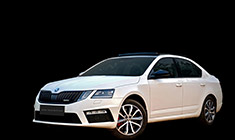News
Replacement for displacement: Yes or no?
I am also a fun of larger capacity engines and love their excellent low-end torque delivery and abundance of power reserves at all points BUT do we really big gas-guzzling engines when their smaller counterparts can do the job at a similar level?
BHPian Kanwar7421 recently shared this with other enthusiasts.
Hello to all the fellow Team-BHPians. This is my first post on this forum and I'd like to start this journey with a question that has kept my brain cells busy since the last 3 days.
The question is "Have Automobile companies really found a replacement for displacement?"
Let me take an example of 2 of India's favorite 'real' SUVs - Toyota Fortuner and Ford Endeavour
1. Fortuner was launched in 2009 and it came with a 3.0L 4-cylinder turbocharged diesel engine producing 171PS of power and 360Nm of torque. Presently, the 2nd generation facelift comes with the 2.8L 4-cylinder turbocharged diesel engine producing 201PS of power and 500Nm of torque. The engine capacity was downsized by around 200cc whereas the power and torque outputs increased significantly.
2. Ford Endeavour 2nd generation which was launched in 2015 came with the massive 3.2L 5-cylinder turbo diesel engine producing 197PS and 470Nm of torque. But due to implementation of BS6 emission norms, Ford introduced the new 2.0L 4-cylinder turbo diesel which churned out 168PS and 420Nm of torque. The engine capacity was downsized by nearly a K12 series engine (1,200cc) yet the decrease in power and torque output was only around 30PS and 50Nm respectively.
I know that as time progresses, newer engine technologies are developed due to which the power and torque outputs are not drastic even after engine capacity downsizing BUT if a smaller displacement engine developed with tech produces better power than its larger capacity counterpart which was developed 4-5 years back. Then in what areas will the larger engine be better so as to prove the statement "There is no replacement for displacement"
And......in 2022, if I want to buy a true BOF SUV like the Thar or Scorpio-N, can their TGDI Petrol engines (if FE is not much of a concern) be the better choice or follow the universal option that an SUV has to have a diesel engine.
P.S -> I am also a fun of larger capacity engines and love their excellent low-end torque delivery and abundance of power reserves at all points BUT do we really big gas-guzzling engines when their smaller counterparts can do the job at a similar level?
Here's what BHPian vishy76 had to say on the matter:
Whatever you have assumed above about Ford's 3.2 and 2.0 is purely on paper. The same applies for many other engines too. On paper, I can make a downsized engine a lot more powerful than its larger counterpart by putting a bigger turbo. But have you considered factors like tractability and reliability? A large turbo bolted to a smaller engine can in many cases lead to turbo lag. It will cause the power delivery to be peaky. Such engines are irritating to drive in traffic due to poor low end torque. I believe the 2.0 turbo by Ford suffers from the same issue, but it is reduced to an extent thanks to the closely spaced ratios of the 10-speed gearbox.
Secondly, I firmly believe this "downsizing trend will help fuel efficiency" tactic to be pure BS, especially when it comes to petrol engines. What I have noticed personally is that turbo petrols (even 1.0L displacement engines) are very sensitive to the way you drive them and their urban fuel economy isn't all that great. Simple reason again being they are off-boost in city traffic. On the highway, sure, you can get good fuel economy if you are in the turbo zone. However, NAs are a lot more predictable in terms of fuel economy and the despairity between urban fuel economy and that on the highways isn't much.
I am not saying downsized engines are bad. I have had the time of my life driving some very potent low displacement direct injection turbo petrols. It's just that some of the claims wrt fuel economy and on paper figures are over the top. Power figures on paper are just that. Power figures on paper. There's a lot more to an engine than this. There's a reason why a Bolero 2.5 DI will do a much better job in hilly regions than a 2.0 Turbo diesel, even though the diesel might make twice as much power and torque as the 2.5.
Downsizing also often means manufacturers end up integrating complex tech (direct injection, turbocharging etc) and developing relatively high stress engines. I don't think this is a good thing from a reliability POV.
I would conclude by saying downsizing is definitely here to stay. It's given rise to some very entertaining engines (1.0L TSI, 1.0 TGDI et all), but there are myths surrounding the same and not all marketing statements are to be believed.
Here's what BHPian Rajeevraj had to say on the matter:
The saying itself is probably still true but from a relevancy point probably not too much especially in the mass market space. Mainly because with the advances in tech, smaller displacement more powerful engines with turbos are becoming the norm now and they probably meet the needs of say 98% of the people out there. So there is no real need for manufacturers to keep building higher displacement engines.
Having said that, even with the turbo petrols for example, displacement still plays a major role. For example the VAG group has the 1.0,1.5,1.8 and even 2.0 TSIs. I am sure given a choice we would all prefer a 2.0 TSI.
Here's what BHPian Shreyans_Jain had to say on the matter:
This saying is applicable and will always be applicable as long as internal combustion engines remain in use. Two engines of similar outputs, one larger than the other, the larger one will always be more tractable and less strained. Which means better drivability, better reliability and more consistent fuel economy under varied conditions.
Here's what BHPian dhanushs had to say on the matter:
With all hardware and add-on's similar, YES, there is still no replacement for displacement.
Electronics can try but, not completely compensate for real hardware!
Here's what BHPian Jeroen had to say on the matter:
It has always been an ambiguous statement at best. It suggest more Volume is better. Better for what? Power, torque, fuel efficiency, reliability, noise, emissions, size, weight, maintenance? All these factors influence one another. All of those factors are relevant for car engine design. Any engine is always a comprise of many different aspects.
The simple truth was that it was never true. Has been one of the myths of the car scene for many decades. It stems from the bootleg days in the USA. Those good old boys did not have any sophisticated means to enhance the performance of their old bangers. When you need to outrun the cops delivering your moonshine, the only option is to shove a bigger engine in the same car. They were actually very good at doing so. Perhaps a bit crude, but very effective, especially on those big American cars. Very American, bigger is better, no matter what, not much finesse in those days.
This eventually became what is currently NASCAR. They still do without turbocharger cranking out some 600BHP.
Read BHPian comments for more insights and information.





_0_0.jpeg)

.jpg)


.jpg)








